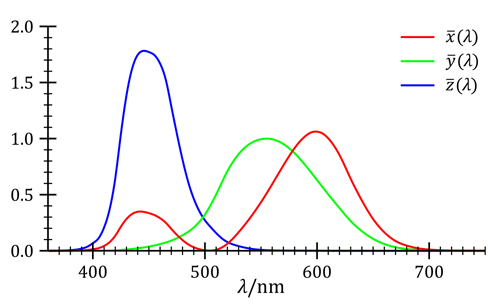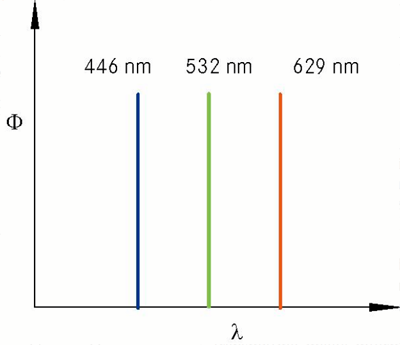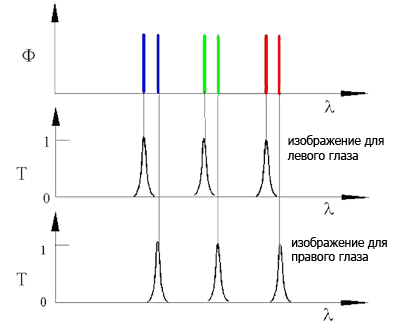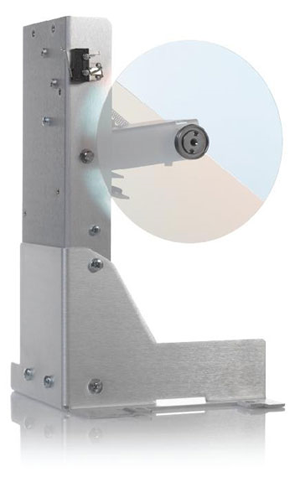Dolby 3D. Based on the movie "Avatar"
Probably, many have already heard about the magnificent work of modern cinema called "Avatar". If you are still not aware of this creation, then I want to draw your attention to some facts:
In my humble opinion, it turned out neither more nor less than - a masterpiece , which had not been oh how long ago, and it is unlikely that within a few years something comparable in scale, beauty and depth will appear.
However, it would not be so bright and fascinating if it were not for one of the technologies that we are talking about in this topic.
It is assumed that the reader already knows something about the methods of obtaining the effect of a 3D image using anaglyph glasses of different colors, or glasses with an alternative shutter of each eye. If you encounter this for the first time, then I recommend to get to the bottom with the help of the Wiki:
')
Wikipedia - Stereo Image
Wikipedia - Anaglyph
Today, almost all new cinemas are equipped with this, at first glance, an intricate system for creating stereo images. What is it, and why did ordinary anaglyphs disappear so quickly?
In short, Dolby 3D is the commercial name of the system for creating a stereoscopic effect by mixing images with different wavelengths (English "stereoscopic visualization tool by wavelength multiplex imaging") developed by the German company Infitec .
The name Infitec comes from the words " In terference fi lter tec hnology", which actually reflects the main area of research and development of this company - technologies related to the use of the interference effect (in this case - light waves). Initially, this 3D technology was created by Daimler Chrysler for virtual reality used in automotive design. In 2006, Infitec merged with Dolby Laboratories to develop the Dolby 3D standard, which ultimately for the average user resulted in an interesting, affordable and fascinating technology that allows you to never dive deep into the atmosphere of the film without losing a bit in beauty. view.
So let's start in order. The light that comes into the human eye can be divided into three spectra, comparable to the receiving receptors of blue, green, and red. The sensitivity of these receptors, depending on the wavelength, was measured by smart scientists, and they reflected the result of the work done in the form of such dependencies:

Figure 1. The three-color spectrum of human perception by different receptors
As you all probably already guessed, specific receptors have certain and fairly accurate working ranges, beyond which their contribution to the creation of images in our mind tends to zero. In addition, the width of the emission spectrum, as a rule, is not decisive, it only determines the degree of saturation of the primary color, however, even when using monochromatic laser emitters, it is possible to get a very rich picture.
Thus, in order to get a good color image, it is enough to use only three light sources with a very small width of the spectrum of each of them:

Figure 2. Laser Display Spectrum
When using such displays there is one most interesting opportunity - parallel transfer of information about the image in different triplets of primary colors. In order to transmit this information to the appropriate receiver (which in this case is the eye of the viewer), the information must be filtered by analogy with filtering an RF signal using an oscillating circuit.

Figure 3. Display spectrum (a) and input filter characteristic (b)
At optical frequencies, the analogs of oscillating circuits are interference filters with a high Q value, made using the technology of deposition of thin layers of dielectric films on a transparent surface, for example glass. Physically, interference filters are paired resonators in which the number of resonators determines the selectivity of the filters.
Then everything is simple. Taking two triplets B1-G1-R1 and B2-G2-R2 and creating pairs of filters for the light source and for the receiver, we get two completely different images at the output when viewing them through different receiving filters (for the left and right eyes).

Figure 4. Creating a stereoscopic image using two color triplets.
The difference between the wavelengths of one color for each eye can be up to 50 nm. This value is due to the good sensitivity of each receptor when deviating from their working maximum.
The implementation of a film projector with two working triplets of colors is very delicate and prohibitively expensive, so the engineers created a simpler device. It can be used with projectors already installed.

Figure 5. Dolby 3D Rotating Disk
The principle of operation of the disk is quite simple - it is placed between the projector and the screen, the two half circles are filters for images of the left and right eyes, while working it rotates at high speed to ensure alternate switching of filter elements of different wavelengths. On each frame of the film, the disc rotates 3 times, that is, at the standard film frequency of 24 frames per second, the disc rotates at a speed of 3 * 24 * 60 = 4320 revolutions per minute.
Disk operation is synchronized with the projector using a special device:

Figure 6. Dolby 3D Disk Synchronizer and Projector
In addition to its direct function, this device has two buttons, with the help of which the disk can be either pushed into the projector's working area or removed from it, which allows you to easily use the projector to show ordinary movies without serious manipulations.
Speaking of the projector ... Although it was not necessary to reinvent a completely new projection device, replacing a standard film projector is still required, because synchronization with the filter requires the same high frame switching frequency, which means that in a second it should update the image with a frequency of as many as 6 * 24 = 144 fps. These requirements correspond to modern digital projectors, which are replacing conventional film. Currently, the main suppliers are NEC, Barco and Christie. All of them are built on 2K D-Cinema DLP technology (2K = 2048px x 1080px) and most of them use lamps with a color temperature of 6K. On the first projectors for 3D, there was a problem of not turning the DLP micromirrors as fast as possible, which led to an incomplete illumination, and as a result, only 2/3 of the total flux from the total flux was on the screen. Perhaps now the situation has improved.
As filtering elements of the image receiver, use glasses of this form:

Figure 7. Dolby 3D glasses
Unfortunately, I don’t know anything remarkable about them, so let’s leave them as they are - glasses with layers of an unknown dielectric sprayed on :)
The cost of equipment is about $ 26,000, points about $ 50.
As you can see, everything is not as difficult as it seemed at first glance. The technology was created, the bridgehead for conquering 3D worlds is open, it remains the case for a small one - to make another dozen films similar to Avatar ...
At this point I want to finish my story, the basis for which was this document .
Comments and additions are welcome.
PS Article is written by my friend, who for some reason still does not have his own account on Habré. Can you help him with this :) .
Thanks for the invite hellt. The author of the Dipp article is now among us.
- The creator of the film - the great James Cameron (Titanic, Terminator 1,2 - his work)
- The script and ideas for the film appeared so long ago that before work began, people just waited for the emergence of technologies capable of realizing their plans on the screen
- the project was created for a long 14 years
- budget painting $ 237,000,000
In my humble opinion, it turned out neither more nor less than - a masterpiece , which had not been oh how long ago, and it is unlikely that within a few years something comparable in scale, beauty and depth will appear.
However, it would not be so bright and fascinating if it were not for one of the technologies that we are talking about in this topic.
It is assumed that the reader already knows something about the methods of obtaining the effect of a 3D image using anaglyph glasses of different colors, or glasses with an alternative shutter of each eye. If you encounter this for the first time, then I recommend to get to the bottom with the help of the Wiki:
')
Wikipedia - Stereo Image
Wikipedia - Anaglyph
Today, almost all new cinemas are equipped with this, at first glance, an intricate system for creating stereo images. What is it, and why did ordinary anaglyphs disappear so quickly?
In short, Dolby 3D is the commercial name of the system for creating a stereoscopic effect by mixing images with different wavelengths (English "stereoscopic visualization tool by wavelength multiplex imaging") developed by the German company Infitec .
The name Infitec comes from the words " In terference fi lter tec hnology", which actually reflects the main area of research and development of this company - technologies related to the use of the interference effect (in this case - light waves). Initially, this 3D technology was created by Daimler Chrysler for virtual reality used in automotive design. In 2006, Infitec merged with Dolby Laboratories to develop the Dolby 3D standard, which ultimately for the average user resulted in an interesting, affordable and fascinating technology that allows you to never dive deep into the atmosphere of the film without losing a bit in beauty. view.
Closer to the point
So let's start in order. The light that comes into the human eye can be divided into three spectra, comparable to the receiving receptors of blue, green, and red. The sensitivity of these receptors, depending on the wavelength, was measured by smart scientists, and they reflected the result of the work done in the form of such dependencies:

Figure 1. The three-color spectrum of human perception by different receptors
As you all probably already guessed, specific receptors have certain and fairly accurate working ranges, beyond which their contribution to the creation of images in our mind tends to zero. In addition, the width of the emission spectrum, as a rule, is not decisive, it only determines the degree of saturation of the primary color, however, even when using monochromatic laser emitters, it is possible to get a very rich picture.
Thus, in order to get a good color image, it is enough to use only three light sources with a very small width of the spectrum of each of them:

Figure 2. Laser Display Spectrum
When using such displays there is one most interesting opportunity - parallel transfer of information about the image in different triplets of primary colors. In order to transmit this information to the appropriate receiver (which in this case is the eye of the viewer), the information must be filtered by analogy with filtering an RF signal using an oscillating circuit.

Figure 3. Display spectrum (a) and input filter characteristic (b)
At optical frequencies, the analogs of oscillating circuits are interference filters with a high Q value, made using the technology of deposition of thin layers of dielectric films on a transparent surface, for example glass. Physically, interference filters are paired resonators in which the number of resonators determines the selectivity of the filters.
So what?
Then everything is simple. Taking two triplets B1-G1-R1 and B2-G2-R2 and creating pairs of filters for the light source and for the receiver, we get two completely different images at the output when viewing them through different receiving filters (for the left and right eyes).

Figure 4. Creating a stereoscopic image using two color triplets.
The difference between the wavelengths of one color for each eye can be up to 50 nm. This value is due to the good sensitivity of each receptor when deviating from their working maximum.
Well, what about movie theaters?
The implementation of a film projector with two working triplets of colors is very delicate and prohibitively expensive, so the engineers created a simpler device. It can be used with projectors already installed.

Figure 5. Dolby 3D Rotating Disk
The principle of operation of the disk is quite simple - it is placed between the projector and the screen, the two half circles are filters for images of the left and right eyes, while working it rotates at high speed to ensure alternate switching of filter elements of different wavelengths. On each frame of the film, the disc rotates 3 times, that is, at the standard film frequency of 24 frames per second, the disc rotates at a speed of 3 * 24 * 60 = 4320 revolutions per minute.
Disk operation is synchronized with the projector using a special device:

Figure 6. Dolby 3D Disk Synchronizer and Projector
In addition to its direct function, this device has two buttons, with the help of which the disk can be either pushed into the projector's working area or removed from it, which allows you to easily use the projector to show ordinary movies without serious manipulations.
Speaking of the projector ... Although it was not necessary to reinvent a completely new projection device, replacing a standard film projector is still required, because synchronization with the filter requires the same high frame switching frequency, which means that in a second it should update the image with a frequency of as many as 6 * 24 = 144 fps. These requirements correspond to modern digital projectors, which are replacing conventional film. Currently, the main suppliers are NEC, Barco and Christie. All of them are built on 2K D-Cinema DLP technology (2K = 2048px x 1080px) and most of them use lamps with a color temperature of 6K. On the first projectors for 3D, there was a problem of not turning the DLP micromirrors as fast as possible, which led to an incomplete illumination, and as a result, only 2/3 of the total flux from the total flux was on the screen. Perhaps now the situation has improved.
As filtering elements of the image receiver, use glasses of this form:

Figure 7. Dolby 3D glasses
Unfortunately, I don’t know anything remarkable about them, so let’s leave them as they are - glasses with layers of an unknown dielectric sprayed on :)
The cost of equipment is about $ 26,000, points about $ 50.
Fin
As you can see, everything is not as difficult as it seemed at first glance. The technology was created, the bridgehead for conquering 3D worlds is open, it remains the case for a small one - to make another dozen films similar to Avatar ...
At this point I want to finish my story, the basis for which was this document .
Comments and additions are welcome.
PS Article is written by my friend
Thanks for the invite hellt. The author of the Dipp article is now among us.
Source: https://habr.com/ru/post/78804/
All Articles
